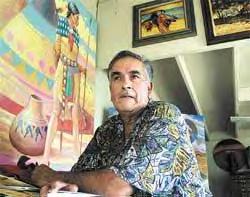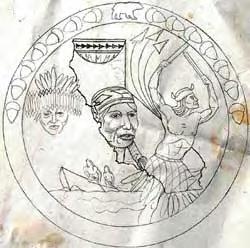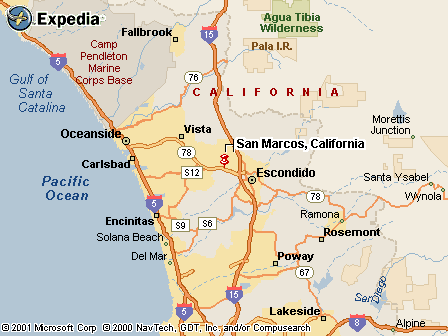|
|
Canku Ota |
|
|
(Many Paths) |
||
|
An Online Newsletter Celebrating Native America |
||
|
October 20, 2001 - Issue 47 |
||
|
|
||
|
San Marcos Artist Designs New Seal for State Capitol |
||
|
by Katherine Marks Staff Writer North Country Times-October 10, 2001 |
||
|
Jamie Scott Lytle / Staff Photographer |
 SAN MARCOS
---- Robert Freeman's work is on display throughout the world and soon the noted American Indian artist will be
able to count one more venue: the California state Capitol. SAN MARCOS
---- Robert Freeman's work is on display throughout the world and soon the noted American Indian artist will be
able to count one more venue: the California state Capitol. San Marcos artist Robert Freeman was chosen from more than 70 other artists to design a seal that will hang at the state Capitol. The seal commemorates contributions by American Indians. The committee, formed by the state Legislature earlier this year, selected Freeman's design over three other finalists last week, Burt said Tuesday. A second seal, designed by Donna Billick and Susan Shelton, both of Davis, will commemorate the contributions made by those of Spanish and Mexican descent. The committee was "impressed by both his academic and artistic background and his experience with public art works," Burt said. On Tuesday, in an interview at his home, Freeman displayed a worn piece of paper with the sketch he made before designing his first model. The 3-foot Sheetrock model he took to Sacramento last week will be used to make the 6-foot bronze seal that will be placed on the front steps of the state Capitol. Freeman was awarded $1,000 to make the model and will receive another $25,000 for creating the winning seal. "The recognition is more exciting than the money," Freeman said, seated with his wife Edwina. The couple have lived in their San Marcos home off Curry Comb Drive since 1969. "This is for posterity." Freeman chose to depict American Indian tribes throughout the state on the seal. The middle of the seal will have an outline of the state with a Karok woman. At the top of the state a basket will be etched. Off to the left is a Hoopa man in a headdress. Below him are Shumash Indians rowing a boat. The coastal tribe was known for its seafaring boats. To the right is a Cahuilla bird dancer.  The selection of Freeman's seal is just the latest achievement in a storied career. His work hangs across the country and the Smithsonian Institution in Washington D.C. purchased some of his artwork in July. It also hangs in countries such as Germany and Japan. Freeman was born on the Rincon reservation near Valley Center. His mother was American Indian, but his name bespeaks his Welsh ancestry. He has lived in San Diego County nearly all of his life. He began painting after a year-long stint in the Army, where he served in Korea. His service ended in 1959 and by 1960 he had married Edwina. In the small apartments they rented for the next several years Freeman would use leftover house paint, cereal boxes, shoe polish, nail varnish, whatever he could get his hands on to create. "The creative process goes on all the time. It never stops," Freeman said. He worked in construction and as a mail carrier before becoming a full-time artist in 1967. He'd already starting showing art by then. Money wasn't an issue for Freeman when he switched his career, he said. "We were so poor it didn't make a difference. Today I would not do it." By 1964, he'd won a national award. More would follow. His work began hanging in galleries. He published calendars and joke books, some of which have been translated into German. When he travels politicians and actors recognized his name. In 1974, he went to Palomar College on the GI Bill and took classes. After graduating in 1976 he became a teacher there the following year. Two of his murals can be seen at the Rincon Casino. The Los Angeles County Library has one of his sculptures. Today his home is filled with his work. In his den an old fence post has been carved to resemble the stretched out head of a horse. A coffee table rescued from a garage sale has been transformed into an image of an embracing couple. Everywhere one looks there's a vivid burst of color, an etching here an intricately carved sculpture there. His garage shelves are lined with paintings of all sizes. On one wall there's a large painting of an American Indian woman with sculpted legs wearing red heels. A similar painting of a statuesque high-heeled woman with a basket on her hip and a dog at her side is tucked into one of the many cabinets. The two paintings have a sensuality that's rare in a lot of American Indian art, Freeman said. "People always want to portray Indian women as fat and subservient," he said. He hopes the seal will help show a more diverse view of American Indians. But he said the seal also recognizes a rich history that is often overlooked. "It's way overdue," Freeman said. |
|
|
|
|
||
|
|
||
| Canku Ota is a free Newsletter celebrating Native America, its traditions and accomplishments . We do not provide subscriber or visitor names to anyone. Some articles presented in Canku Ota may contain copyright material. We have received appropriate permissions for republishing any articles. Material appearing here is distributed without profit or monetary gain to those who have expressed an interest. This is in accordance with Title 17 U.S.C. section 107. | ||
|
Canku Ota is a copyright © 2000, 2001 of Vicki Lockard and Paul Barry. |
||
|
|
|
|
|
The "Canku Ota - A Newsletter Celebrating Native America" web site and its design is the |
||
|
Copyright © 1999, 2000, 2001 of Paul C. Barry. |
||
|
All Rights Reserved. |
||

